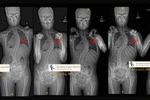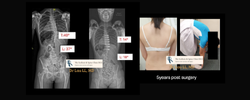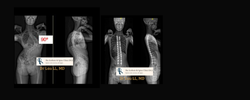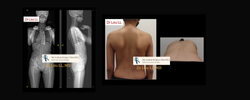Adolescent Idiopathic Scoliosis in Singapore:
Detection, Management and Surgical Consideration
By Dr Lau LL | drlauspineclinc@gmail.com | Singapore | Published on 25 August 2025
The Scoliosis & Spine Clinic (SG) provides expert care for adolescent idiopathic scoliosis (AIS), the most common spinal deformity in children aged 10–18. AIS is characterized by a lateral curvature of the spine with no known cause. In Singapore, early detection and personalized management are key to preventing curve progression and avoiding surgery. This article explores how scoliosis is detected, the available management strategies, and when surgical intervention may be necessary.

How Is Scoliosis Detected?
In Singapore, scoliosis screening is routinely performed in schools using the Adams’ Forward Bend Test, named after Dr Robert Adams. This simple visual test helps identify asymmetry in the back, such as:
- Uneven shoulders or hips
- Rib hump or prominence on one side
- Waistline asymmetry
If a curve is suspected, a referral is made for radiographic evaluation. A Cobb angle greater than 10° confirms scoliosis. Additional assessments include:
- X-rays to measure curve severity
- Skeletal maturity grading
What Are the Management Strategies?
Management depends on curve severity, growth potential, and progression risk. The main strategies include:
Observation
For curves 10–20°, regular monitoring is recommended in at-risk patients. Most mild curves remain stable and do not require intervention.
Bracing
For curves between 20–40° in growing adolescents, bracing can prevent progression. The goal is to wear the brace for 16–20 hours daily until skeletal maturity.
Physiotherapy
Targeted exercises such as the Schroth method may improve posture, core strength, and curve control. Physiotherapy complements bracing and enhances body awareness.
Psychosocial Support
Adolescents may experience body image concerns. Supportive counseling and peer groups can help maintain emotional well-being during treatment.
When Is Surgery Considered?
When conservative measures such as bracing fail and the Cobb angle exceeds 35–40°, surgical intervention may be recommended to prevent further progression and restore spinal alignment. Two main categories of surgical options are available:
Growth-Preserving Option
Vertebral Body Tethering (VBT) is a minimally invasive technique considered for skeletally immature patients with high risk of curve progression. VBT uses a flexible cord anchored to the vertebrae to modulate growth and gradually correct the curve while preserving spinal motion. It is typically indicated when:
- Cobb angle is between 35–40° or more
- Bracing has failed to halt progression
- Patient has significant remaining growth potential

Conventional Surgical Methods
For patients with mature skeletons or severe curves typically 45–50°, conventional surgical correction is preferred. These include:
- Posterior Spinal Fusion: The gold standard technique using rods and screws to realign and stabilize the spine. It halts curve progression and restores balance.
- Keyhole Endoscopic Scoliosis Correction: A modern, minimally invasive approach using small incisions and endoscopic tools to achieve spinal correction with reduced scarring and faster recovery.


📊 Risk Progression Chart
| Curve Range | Risk of Progression | Management Recommendation |
|---|---|---|
| 10–20° | 80% remain stable | Observation |
| 10–20° | 20% progress beyond 20° | Bracing or surgery may be needed |
Curve Progression Risk & Importance of Expert Evaluation
While scoliosis can appear alarming to families, it’s important to understand that 80% of adolescents diagnosed with scoliosis have mild curves that carry a low risk of progression. These cases often require only observation and routine follow-up.
However, 20% of patients may have curves with a higher likelihood of worsening—especially during growth spurts. These individuals may eventually require bracing or surgical intervention to prevent long-term spinal deformity.
Because early signs can be subtle, it is crucial to consult a spine specialist who can accurately assess curve severity, growth potential, and risk factors.
Expert Assessment of Curve Progression in Adolescent Idiopathic Scoliosis
An orthopaedic surgeon with a focused interest in adolescent idiopathic scoliosis is well-positioned to provide a reliable estimation of curve progression risk. This expertise enables timely intervention while minimizing the need for unnecessary radiographic imaging—balancing precision with patient safety.
Conclusion
Adolescent idiopathic scoliosis is a complex condition that requires timely detection and individualized care. At The Scoliosis & Spine Clinic (SG), we are committed to guiding families through every stage—from initial screening to advanced treatment options. With expert evaluation, modern bracing techniques, and surgical precision when needed, we help adolescents maintain spinal health and confidence throughout their growth years.
Frequently Asked Questions: Adolescent Idiopathic Scoliosis (AIS)
1. Who should I see when I suspect my child has scoliosis?
You should consult a spine specialist or orthopedic surgeon experienced in pediatric scoliosis. Early evaluation helps determine the severity of the curve and whether treatment is needed. Timely diagnosis can prevent progression and guide appropriate care.
2. Can I pursue non-conventional treatments for scoliosis?
You may explore complementary approaches such as chiropractic care, yoga, or alternative therapies. However, it’s essential that your child’s scoliosis care remains supervised by a qualified spine specialist. This ensures the curve does not progress unchecked and allows timely intervention if non-conventional methods fail to control the condition.
3. Why did you not recommend bracing? Why is bracing not for everyone?
Bracing is most effective for moderate curves in growing children. If the curve is too mild, too severe, or the child has completed growth, bracing may not help. In such cases, observation or surgery may be more appropriate. Recommendations are based on age, curve type, and growth potential.
4. Bracing seems difficult—why do you recommend it?
Bracing is a non-invasive method that can slow or stop curve progression during growth. While it may feel restrictive initially, modern braces are designed for comfort and effectiveness. With proper support and education, most children adapt well and benefit significantly.
5. Is my child suitable for non-fusion techniques?
Non-fusion techniques like vertebral body tethering (VBT) may be suitable for children aged 10–14 with moderate, flexible curves and significant growth remaining. These methods aim to correct the curve while preserving spinal motion. However, not all patients qualify—suitability depends on age, curve type, flexibility, and skeletal maturity. A detailed evaluation by a scoliosis surgeon is essential.
6. Why do you even recommend surgery? It seems so invasive.
Surgery is considered when the spinal curve is severe or progressing rapidly despite bracing. It helps prevent long-term complications such as posture imbalance, chronic pain, or lung restriction. Modern techniques are safe and precise, with excellent long-term outcomes.
7. Is surgery the only option?
No. Surgery is only recommended when non-surgical methods are unlikely to succeed. Many children benefit from observation, physiotherapy, or bracing. Each case is carefully evaluated before any surgical recommendation is made.
8. What is the post-surgical recovery like?
Most patients are up and walking within a few days. Recovery includes wound care, physiotherapy, and gradual return to daily activities. Full recovery typically takes 2–3 months, with ongoing support from the care team.
9. When can I return to school?
Most students return to school within 3 to 6 weeks after surgery, depending on individual recovery, comfort, and energy levels. We provide medical leave documentation and help plan a smooth transition back to school life.
10. Can my child return to sports after treatment?
Yes, most children can return to sports after scoliosis treatment. The timeline and type of activity depend on the treatment method and individual recovery.
– After bracing or observation: non-contact sports like swimming or walking are usually safe.
– After surgery: light activities can begin within weeks, with non-contact sports by 3–6 months and contact sports after 6–12 months.
Your surgeon will guide you based on your child’s progress and spine healing.
11. Can my child continue with OBS (Outward Bound Singapore) with scoliosis?
Many children with mild to moderate scoliosis can safely participate in OBS. These curves typically do not limit physical activity, and children can engage in most outdoor challenges without restriction.
However, if your child has undergone surgery, some limitations may be necessary depending on the stage of recovery and the type of activities involved. For children with severe scoliosis, there may be underlying cardiac and respiratory compromise that affects endurance, stamina, and safety during strenuous activities.
It’s important that your child’s participation is guided by a spine specialist who can assess physical readiness and provide medical clearance if needed.
12. Do you help me with insurance claims?
Yes. Our clinic assists with insurance documentation, pre-authorisation forms, and coordination with major providers. We aim to make your treatment journey smooth and stress-free.
13. Why is it important to see surgeons who are experienced in this area?
Scoliosis surgery requires precision and expertise. Experienced surgeons understand spinal growth, curve correction, and long-term outcomes. Choosing a specialist ensures safer procedures, better results, and peace of mind for your family.
If your child has been diagnosed with scoliosis or is undergoing evaluation, bracing, or even for consideration for surgery, please visit our contact page to arrange a personalized consultation or discuss next steps.
